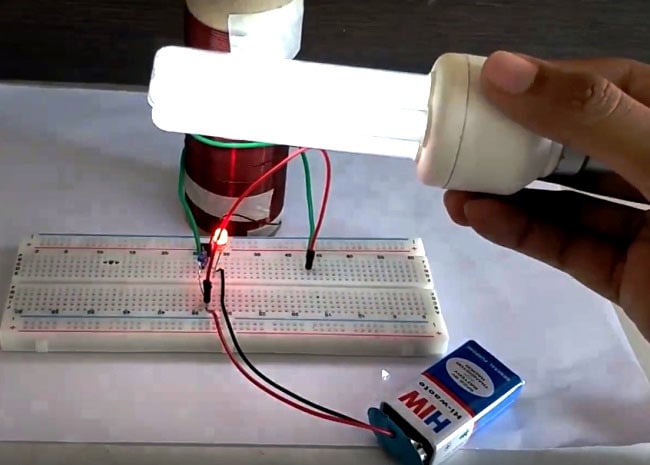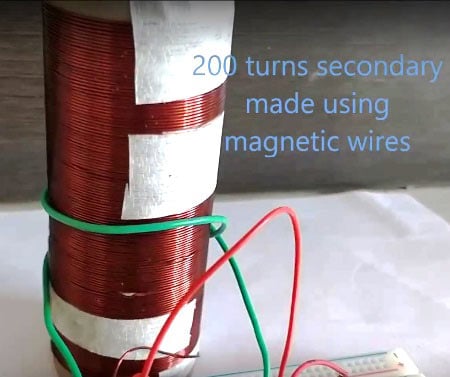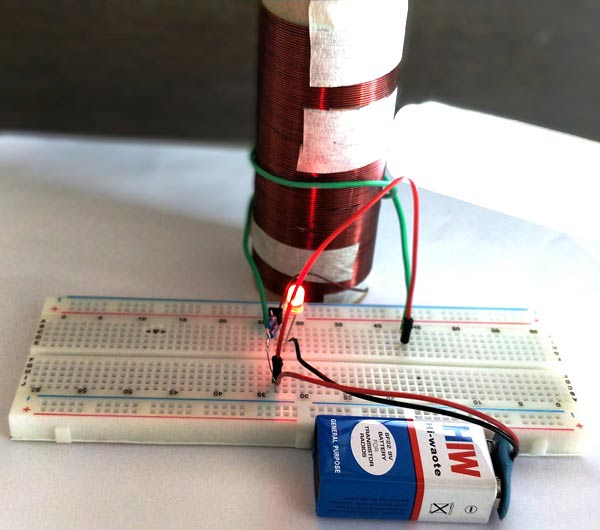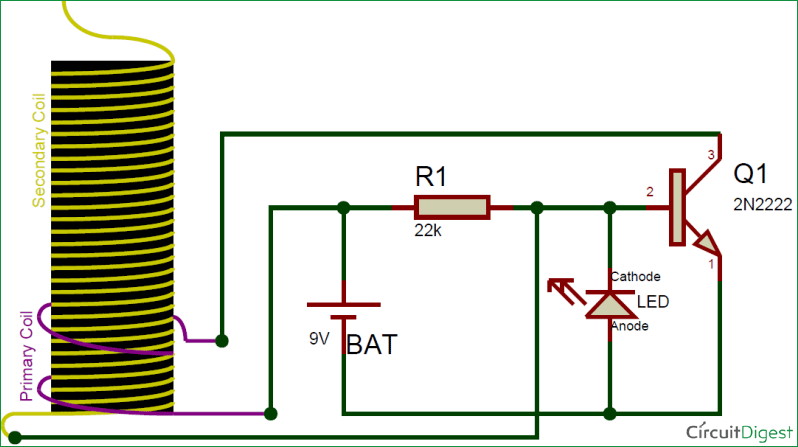
Be it an ordinary high school project or a mind-blowing arcing project, a Tesla Coil is always fun to build and will definitely make your project look cool and attractive. A Tesla Coil is a simple coil that creates a high voltage electric field in the air when a small input power (9V) is provided, this electric field is strong enough to glow small light bulbs. This principle was invented by Nicola Tesla, who also holds the credit for inventing Induction Motors, AC current, neon bulbs, Remote controls, etc..
This Mini Tesla Coil Circuit is very simple and just works with a help of a 9V battery and very few commonly available electronic components, which makes it is very easy to build (fingers crossed). There are a handful number of people who have tried this project already and have failed to obtain the result; this is mainly because of a few subtle mistakes that commonly occur. So it does not matter if you have already given up on Tesla coils or if you are completely new to this topic, this tutorial will be your final stop to build and debug your Tesla coil and get it working. In this DIY tutorial, we will learn How to Make a Simple Tesla Coil with 9v Battery and transmit the power wirelessly.
Warning: This is a high voltage project, so make sure you always know what you are doing. The voltage is not lethal but still can cause nerve and tissue damage if you get in direct contact with any arcs. You don’t have to fear much, but always remember not to touch the coil while it's powered ON.
Components Required to build a Miniature Tesla Coil
- Magnetic wire a.k.a Enameled copper wire
- 22K Resistor
- 2N2222 Transistor
- LED
- Ordinary breadboard wire
- Any non conductive cylindrical object
- 9V Battery (or 5V Supply)
- Breadboard
Mini Tesla Coil Working:
Before we start building the Tesla coil, it is very important to know how it works. Only then we will be able to build and debug one successfully. The Tesla coil works with the principle of Electromagnetic Induction. According to which, when a conductor is placed under a varying magnetic field, a small current will be induced inside the conductor. For a Tesla coil this conductor will be called as the secondary coil and the varying magnetic field will be produced by the primary coil by passing an oscillating current through the primary coil.
It might sound a bit confused, but let us proceed with the circuit diagram where things will be made much clear.
Mini 9V Tesla Coil Circuit Diagram:
The circuit diagram of Mini Tesla Coil Project given below is very simple. So let us understand how it works and learn how to build it. The main component in this mini tesla coil diagram is the secondary coil (golden colour), which is made by winding a magnetic wire (enameled) around a cylindrical object (any non conductive object will work).
A high current high frequency transistor like 2N2222 is used to supply current through the primary coil (violet colour). The whole set up is powered by a 9V battery as shown above. The positive end of the battery reaches the collector of Transistor through the primary coil, and the emitter is grounded. This means that whenever the transistor conducts, current is flown through the primary coil. The LED diode and one end of the secondary coil is also connected to base of transistor to make the circuit oscillate, this way the transistor will send a oscillating current into primary coil. If you want get more technical and learn how the current oscillates you can Google for “Slayer Exciter Circuit”.
So, with this arrangement we have a primary coil which will have an oscillating current, and hence will produce a carrying magnetic flux around it. Now, this coil is wound around the secondary coil and hence a according to law of electromagnetic induction a voltage will be induced in the secondary coil. Since the number of turns in the secondary coil is very large than primary coil, this voltage will be a very high voltage and hence this coil will have a very strong electric flux around it that is powerful enough to glow normal CFL bulbs and is used in Wireless Power Transmission.

Winding the Secondary Coil:
One very important step in this project is winding the secondary coil. It is a time consuming process and hence do not rush yourself in this part. First of all, you will need a magnetic coil, which is also called as enamelled coil wire. These wires can be found inside relays coils, transformers and even motors. You can either reuse one or buy yourself a new one. The thinner the wire is the better the results will be.
Once you are ready with the magnetic wire, you will need a cylindrical object. The only rule while selecting this object is that it should not be conductive, you can select PVC pipes, cardboard roll or even stack 4-5 A4 sheets together and roll them up. The diameter of the cylinder can be anywhere between 5cm to 10cm, and the length should be at least 10cm. The longer the object is more number of turns it can fit in.
After getting your coil and cylindrical object, it is time to start the winding process, just wind few turn and use a tape to secure the winding initially and then proceed with the complete winding. Make sure you follow the below tips while winding
- Wind the coils as close as possible
- Do not overlap one coil turn over another
- Try to get a minimum of 150 turns, a value of 300 turns will be typically good.

Common Misconceptions:
Although this circuit works and behaves like a Tesla coil, it is far away from an actual Tesla coil. The right name for this circuit is slayer exciter tesla coil or Poor mans Tesla coil. You can learn and have fund with this circuit, but be advised this is not a Tesla coil. That being said let's proceed with our project. Once we are ready with the coil we are almost 90% through the project after that just follow the circuit diagram and make the connections, but there are a few commonly asked "why is my tesla coil not working?" questions to which you can find the answers below.
- Do not use a normal transistor in place of 2N2222, unless you know to select an exact equivalent for this transistor.
- The resistor 22K need not be exactly the same it can be anywhere from 12K to 30K.
- Make sure the 9V battery that you are using is brand new, because the cheap batteries will not last more than 5 minutes with this circuit, If you have an Arduino or something which can source you +5V you can also use that.
- It is completely fine for your coil to have any number of turns, but it should have a minimum of at least 150 turns, you dint have to be very accurate with the count.
- The circuit can work from 5V to 10V. However don’t push more than 500mA through it
- The LED has a different purpose other than glowing, it is actually used to switch the transistor so do not ignore it, a RED colour LED will work fine.
- Your LED might or might not glow when the Circuit is powered, you do not have to be worried about it.
- You might or might not get a spark (arc) at the free end of Secondary coil, you do not have to worry about that either. If you get an Arc do not touch it.
- Always check if the circuit is working only by using a normal CFL bulb.
- Adding a metal load (foil paper) on top of secondary coil is optional, but it sure will improve the results but not mandatory to get a basic working output.
- There is a very little chance for you to hear any hissing sound, so don’t expect it.
Construction and Testing of 9V Mini Tesla Coil:
Just follow the steps to wind the coil and use a breadboard to make the connection as shown in the circuit diagram. Once you are done with everything your mini Tesla coil project will look something like this.

I dint not have a 22K resistor or anything near, so I used two 47K resistors in parallel as shown in the circuit. Now, finally it is time to have fun. Just power the circuit using a new 9V battery and bring a CFL bulb close to the coil you should be able to watch the CFL bulb glow without any connection on its own just like as shown in the video below. You can also achieve the same effect on tube lights as well. Go ahead and play around with it, there is a lot more room to improve the project, by increasing the current rating or by increasing the number of turns on secondary coil to get arcs on the free end of secondary coil. But, all those things are left for a new tutorial.

You can also check if the circuit is working by using a mulimeter, just place the multimeter in voltage mode. Touch the black probe on the ground of the circuit and leave the red probe floating on the air, the multimeter should be able to read a very high voltage as shown below where the meter reads a very high voltage of 1247V. You have been warned already, be very careful around these high voltage set-up. Learn here How to use a Digital Multimeter.

You can also check the presence of Flux by using a Clamp Type Multimeter in NCV mode. When you bring the Multimeter near to the coil, it will start beeping with the flashig light.

But, wait!!!...., what if your bulb does not glow. Don’t worry it should be a very subtle problem somewhere. A most common solution to try out first is change the polarity of your primary coil, that is connect the collector end of primary coil to battery positive and the battery positive end of primary coil to the collector pin. This should help you to solve the problem. If not, try using a new 9V battery or some other reliable power source.
Even then if you face any problem make sure you have read the common misconception heading above and check for your circuit connection. If everything fails feel free to post your problem as comment below. I will try my best to make your circuit work.
Comments
Hi amit,
The Primary coil can be made by using a normal bread board wire. aka hookup wire. Just make 2 turn around the secondary and it should be done. You can also try any number of turns between 2-5
m es project PR work krna cahta hu can you help me place
coll me-7897280583
my tesla coil is not working what should I do?
Have you tried all the steps metioned above? What voltage did you get when measuring the secondary voltage? Did you try interchanging the primarey terminals? A picture of your set-up can help me find what could be the pblm
I couldn't find any CFL bulbs at my local department store, I was wondering were I might be able to find CFL battery's, if you could reply back to me by my gmail I would be extremely appreciative.
You can use neon lamps if you cant find CFL bublbs. Or you can just use a multimeter to check for high voltage as shown in the video. No you cannot use battery
Can I use the supply voltage more than 9v for tesla coil ???
No you cannot. Just use 9V. Anything more than that will fry your 2n2222
Below 100 turns on secondary
Wat happens, it's not coming
if secondary coil has 200 turns and first one has 2 then shouldn't the Vout/Vin ratio be 100? If so shouldn't the output voltage be maximum of 900V since input is 9V? How come your output read 1200 plus V? Did you do more turns.
You are correct khan, the circuit produces only a maximum of 900V. The meter is not accurate with high voltages hence we get error readings. However the point here to check for high voltages which could be achived by these meters
I wind up over 500-600 turns can i use 15 volt dc supply
i keep frying 2222a transistors. if i keep the bulb close when i turn it on it works until 8 move bulb away. then transistor smokes. what am i doing wrong?
What power source are you using? the only reason i could think of for burning your 2n2222 is excess current.
kindly explain how a tesla coil works ? means why we r using a transistor and a resistor in this circuit nd can't directly use a 9v battery ?
PLz explain even the minor details of the physics concept behind this circuit.
It's very imp as i have my final practical
so reply as early as possible.
ur videos and explanation are really very helpfil.
Thank you so much for your kind information
I made a Tesla coil successfuy, it's working but l faced one problem that's on working the transistor becomes very hot and it burnned two times
How l could solve this problem and make the transistor safe
Best regards
Yes its very common to have faced this problem. What power source are you using? One better solution is to find a transistor that has better current rating than 2N2222
Hi, Can I use any other transistor??
First of all it was a very delightful instructions. try it at home. And i successfully made it. I measure it on multimeter i get 1000 plus volt. But it cannot light a CFC bulf. I follow all the instructions but why it can't glow a CFC bulb. It should be noted that it also create a magnetic field but it doesn't work. What should i do now?
I can get the LED to light but not the bulb, tried switching the polarities already but that didn't do anything. Please help me.
Of what volts should the 22k resistor should be so as to work properly and how many turns on 1St ans 2nd coil
Mini tesla in i use KN 2222A TRANSISTAR
sir i am made in tesla coil but more no.. of times
fails but please tell me right way sir
Hey guys my telsa is not working but i need to know about how many turns should i twist in the pipe and which resistor i should use and give the correct way and timeingto glow the bulb
Can anyone tell about the calculation of distance of field around tesla coil
Sir can u explain me how does 2n2222a works in the circuit it means that we are providing DC supply and an inductor will works on ac how it is possible
I tried every trouble shooting step.
Battery tests at 9 volts. If I test ground to top end of secondary wire I get .57 volts.
Hi, are you sure the LED is wired correctly on that diagram?
My circuit is not working, even if I use the same components as you do. I tried it twice, and I even tried reversing primary coil, led, battery… It does not work.
How many turn is your secondary coil? What material have you used for your primary and secondary wire?
Hi, can you explain or give me the referrence, why we need 400 turn for secondary coil ?
I've got a 5V reliable source, 500 turns on secondary, and 3-4 turns on the primary. I'm running into issues with it having an effect on the lightbulb and the transistor getting extremely hot. I'm using a 22k Ohm resistor and a Red LED. The LED lights up but nothing happens with the coil. Tried changing the polarity of the primary and still nothing happens. in both cases the LED lights up, Transistor heats up, and no effect on the CLF or detectable voltage on the coil. Suggestions?
The transistor should have not got heated up!!!
What transistor are you using? 2n2222? If yes check your connections, also try replacing the transistor with a new one
I have a doubt regarding the glowing of light bulb. Is it the electric or the magnetic field that is responsible for the light bulb to glow regarding a practical mini tesla coil?????
Sir I want to make a city model in which I am going to use the tesla coil and I am going it on a regular size cardboard. So can you pls tell me how large I make my tesla coil so that it is enough to Cover all the LED bulbs. Pls reply fast..
Sir I would like to do this project
I copied the schematic exactly as shown, and even went off of your pictures. My LED doesn't light, but is dim when I remove the transistor. I'm sure the connections are solid, I'm using a 9V, 2n2222, my only difference is my copper wire has a lot of turns. It's a solid foot long, but I followed all other directions perfectly. Thanks for your help.
Is your transistor getting hot? try changing the transistor as well as the battery with a new one. The battery will get drained very fast so make sure you check its voltage now and then
It was getting hot, I bought a brand new 9v battery and plugged it in, then reversed polarity of the primary wire, The LED will actually light intermittently now but also now the transistor is smoking, I replace the transistor every time (using 2n2222) but it still smokes. Still no effect with a CFL lightbulb, but the beginning part of the secondary coil is pretty hot
The transistor getting hot is not a good sign. How many turns do you have in your secondary? Double check you connections and pinouts with transistors
Sir my transistors is also getting very and the bulb is also not glowing what should I do? Please reply me
Can you please help me with the tesla coil its not working.the primary coil is showing 4volts and secondary coil is showing one. The multi meter is working i checked it on the battery it showed 8volts. Please help me.
Sir I wants to make a tesla coil for my science project. And I am going to show the working of tesla coil in a city and I am going to built a small city to show the working of tesla coil. So can you pls help in making the tesla coil as my tesla coil is not working. So can you tell me should I do to make my tesla coil working and also pls tell me what kind of lights I should use in my model of city that can be lighted up by the tesla coil. Pls reply fast
hy sir which quility of cupper wire i uesd please tell me
Hi, I wanted to make a bigger Tesla coil of 18v what are the materials required for it. Which resistor and transistor should be used for it
Hi, Sir I wanted to make a 15v Tesla coil.
Please guide me about Its Materials Required for it.
Thank you, bro, i make it with using your instructions finally i achieved success in this model i failed two times but it gave me a lot of experience
sir, I did everything but still, it is not working , can u help me out
What do you mean by not working ? Did you check the multimeter voltage as explained ?
Mine secondary coil is of 15cm how much windings should I make for the primary
15cm?
Can anyone help me.. my coil is not working what will be possible errors ??? I have already searched so much but can't find error.. can it be cz of reason I m giving it 5v instead of 9v also tell if any other reason
I have 191 turns on primary how much should i make for secondary
Man i made the circuit and i fell i have checked everything.It would be real nice if i can somehow contact you personally as i have committed this project to my teacher as a CBESE class 12 project.Can you pls give your contact no. facebook instagram .PLEASE!!
My transistor says 2222A on the front is that the right transistor? Thank you hope to hear from you soon.
My Tesla Coil works but not all the time. It's very sensitive, how can I fix that?
Of what diameter copper wire should I use for secondary and primary
And should must it be with coting or without coting plz reply
His name was Nikola Tesla, not Nicholas!
Hi, i have completed the circuit correctly but it is still not working can you please help me.its very important
Hi bro, i thought o f making it, but i heard that it emits high voltage and rf, and its dangerous at some point... Can u tell whats the minimum distance we should keep or will it be dangerous if stand near it or bring our hands close...? Bit of an urgent..Reply ASAP.....
Hello Sir,
I created setup as mentioned in this article.
- New battery
- Tried with reversing transistor
- 28 AWG Copper wire, Wrapped around 9 cm half inch PVC pipe
- For primary winding used breadbord wire
Please have a look at photo of steup and let me know what is wrong.
Hi,
I want to make this project but I was wondering if it was hard to do and if it was dangerous.
Can someone tell me please ?








Hi, this is very interesting and i would like to try out myself.
However you have well explained winding of the secondary coil but there is no guidance on the primary coil winding. How many turns and how to wind it.. will help if you guide on the same as well.
Thanks
Amit